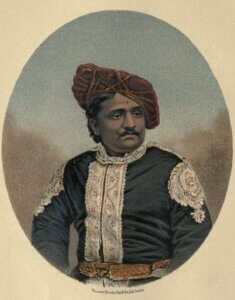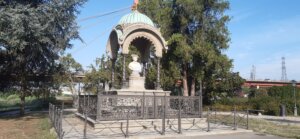15 April in Florence; 23 April in Delhi.

The monument in Florence to Maharaj Chhatrapati of Kolhapur will feature in April in a hybrid conference on Florence and India held in Florence and Delhi. Standing at the confluence of the Arno and Mugnone rivers, the recently conserved monument is testament to the death in 1870 in Florence of the first reigning Hindu prince to visit England and Europe. Raja Ram, aged 20, was on his way back to India. Horrified at being asked to permit a cremation, the city authorities passed the request to the Council of Ministers in Rome. The British Consul, Sir Augustus Paget, came to the rescue of Rajaram’s harried attendants doubtless by wire-pulling and arm-twisting at the Vatican. The Council of Ministers consented and next morning the body of the Maharaj was cremated on the banks of the Arno.
Florence’s English Cemetery – Cimitero degli inglesi, Cimitero Porta a’ Pinti, Piazzale Donatello – and the Prince’s monument are a mirror reflecting the Victorian history of India. Birthplace of the Italian Renaissance, Florence attracted Britons connected with India who found retirement in a warmer climate than England’s and, for some, their last resting place.
The cemetery’s sector A has the tombs of Christopher Webb Smith, 1871, of the Bengal Civil Service, and his wife, 1862, who were largely responsible for the building of the Gothic Holy Trinity Church in the via la Marmora. Nearby are Walter Savage Landor, 1864, while his Swiss wife, who hated him, is portrayed in a life size statue her back turned on him on their son’s tomb. Arnold Savage Landor, 1871, who loved Rose Aylmer, who lies in Calcutta’s South Park Street Cemetery. It used to be said that the English died in India after two monsoons. Sarah Elisabeth Gough. 1841, whose husband, the second Viscount Gough, served in Madras, and who is related by marriage to the noble Florentine Capponi family.
In sector B, are buried Mary Kyd de Dornberg, 1872, whose father was Lt General Alexander Kyd of the Bengal Engineers and was related to Colonel Robert Kyd who founded the Botanical Gardens in Calcutta and lies in South Park Street Cemetery. Theodosia Garrow Trollope, 1865, and Isa Blagden, 1873, were fictionalized by Nathaniel Hawthorne in The Marble Faun. Isa, friend to Henry James, friend to the Brownings, earned her keep by writing novels and boarding guests at Bellosguardo. She and the poet Robert Lytton, later Viceroy of India, fell in love, she saving his life at Bagni di Lucca. Sir Thomas Sevestre, 1842, who visited Napoleon on St Helena, was an old Indian Army surgeon who was called on in the Baths of Lucca to attend a dying duellist. Joseph Garrow, 1857, the son of an East India Company civil servant married to an Indian princess. Orphaned, he was raised by his father’s sister, became a Justice of the Peace in Devon, and was the first translator of Dante’s Vita nova into English.

Sector D has the great granddaughter of Clive of India, Charlotte Mary Florentia Windsor Clive, 1840. Harcourt Popham, 1840, son of Sir Home Riggs Popham who invented Trafalgar’s flag code, married in Bengal, then died in Florence at 28. Sir James Annesley, 1846,‘late President of the Medical Establishment, Honorable East India Company, Medical Board of Madras’, wrote an enormous book on The Diseases of India and of Warm Climates Generally, 1841.
In Sector E are Sir William Henry Sewell, 1862, son of King William IV, served in India (Commander in Chief of the Madras Army) and at Waterloo, his wife, Georgina Sewell, 1872.
Sector F has the tomb of Annie Dallas, 1865, her father in the Indian Army, her mother Australian. Fanny Crewe, 1846, widow of Colonel Richard Crewe of the Madras Army of the East India Company.
The conference is organised by Professor Julia Bolton Holloway, President of the Aureo Anello Associazione and custodian of the English Cemetery, and of the Guild of St George of John Ruskin, and the Gabinetto Vieusseux.
https://www.florin.ms/CBX.html
With thanks to Professor Holloway.
Peter Boon
31 March 2023
